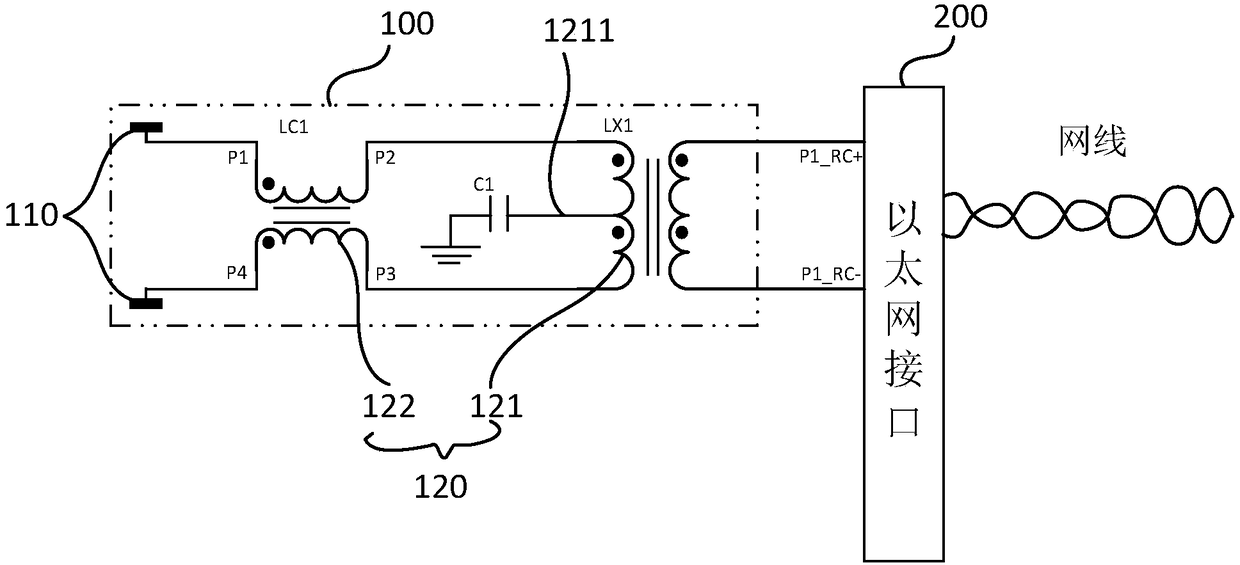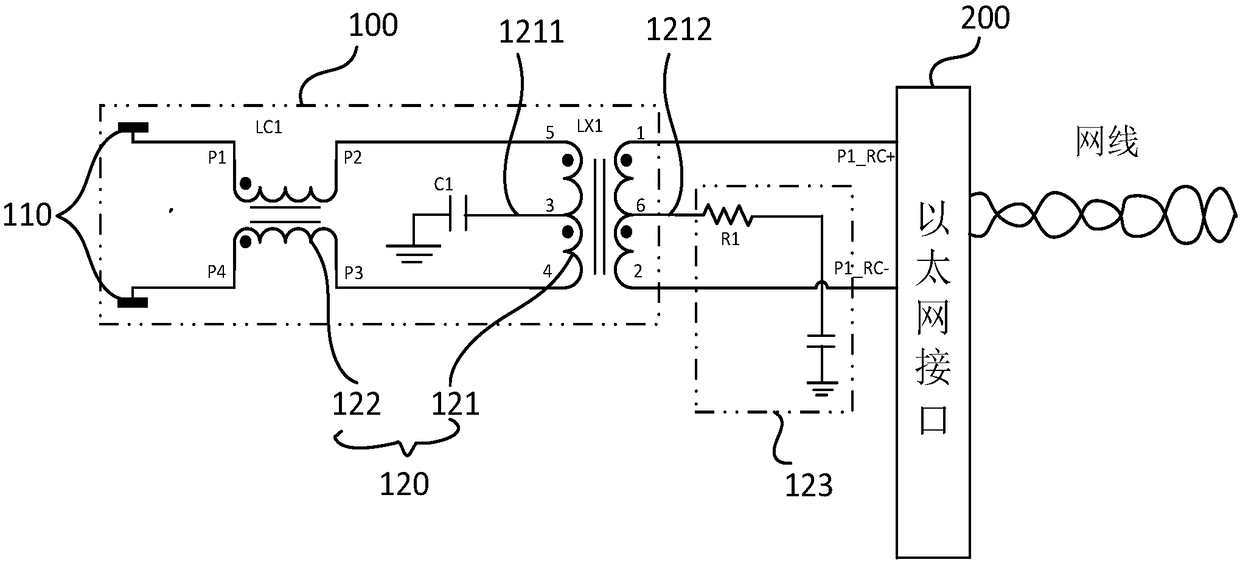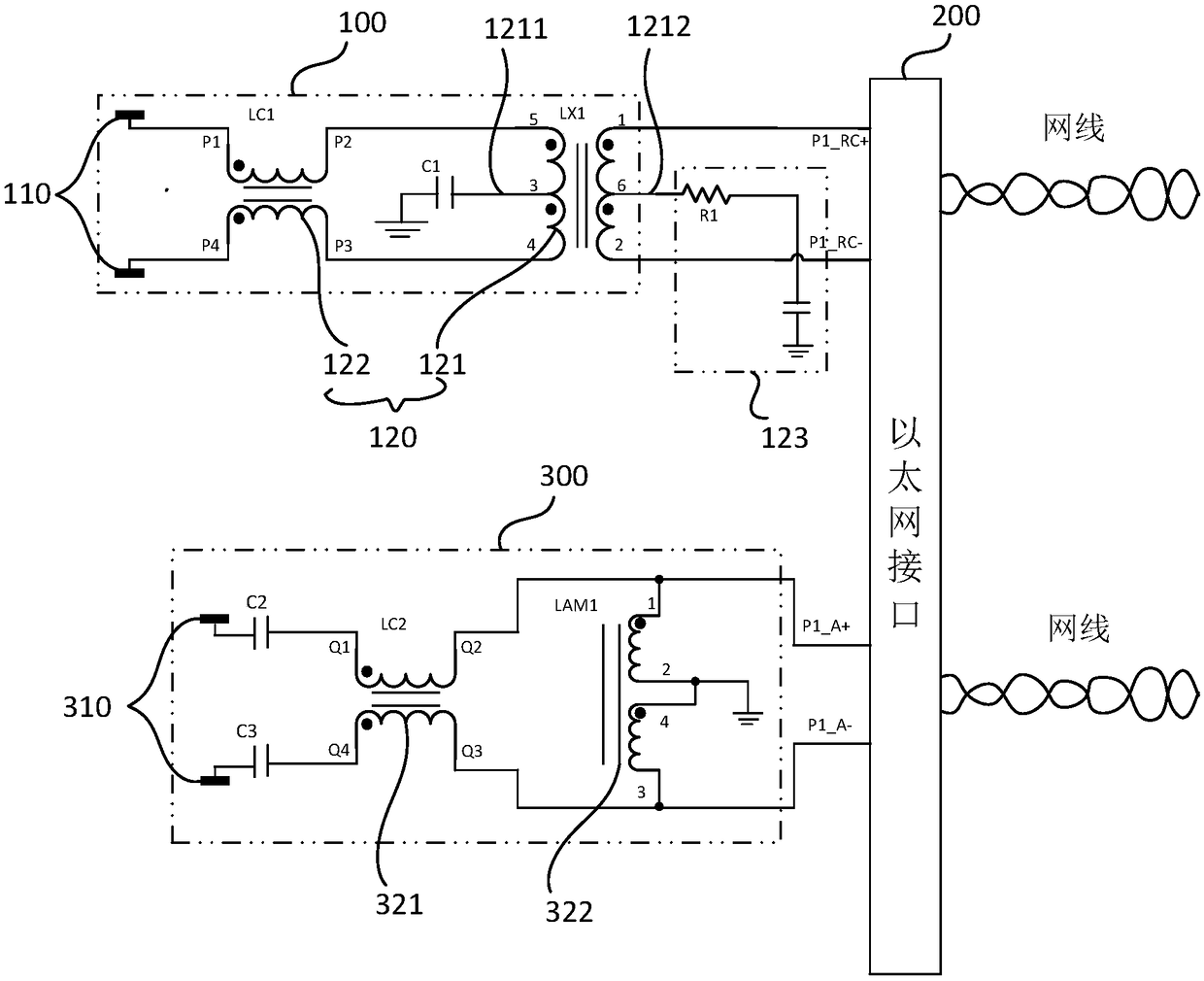Ethernet signal transmission interface circuit, method and network equipment
A signal transmission and interface circuit technology, applied in the field of communications, can solve the problems of only network signal transmission, high cost, large components, etc., to achieve stable and complete signal transmission, reduce procurement costs, and simple circuit structure.
- Summary
- Abstract
- Description
- Claims
- Application Information
AI Technical Summary
Problems solved by technology
Method used
Image
Examples
Embodiment 1
[0027] Such as figure 1 As shown, this embodiment provides an Ethernet signal transmission interface circuit, including a first transmission network 100 and an Ethernet interface 200, and the first transmission network 100 includes a first differential line pair 110 and an inductive signal transformer 120, so The inductive signal transformer 120 includes a pulse transformer 121 and a first common-mode transformer 122, and the two pins P1 and P4 at the first end of the first common-mode transformer 122 are connected to one of the first differential line pair 110 respectively. The two pins P2 and P3 of the second end of the first common mode transformer 122 are respectively connected to the two ends of the first winding of the pulse transformer 121, and the two ends of the second winding of the pulse transformer 121 are connected to In the Ethernet interface 200, the first winding of the pulse transformer 121 is provided with a first center tap 1211, and the first center tap 121...
Embodiment 2
[0034] Such as figure 2 As shown, the difference between this embodiment and the previous embodiments is that the second winding of the pulse transformer 121 is provided with a second center tap 1212 , and the second center tap 1212 is connected to the Bob-Smith circuit 123 .
[0035] Adding Bob-Smith circuit 123 to the second center tap 1212 can help balance the network, eliminate EMI (electromagnetic interference) in Ethernet network signal transmission, isolate high voltage, suppress clutter, and impedance matching, making signal transmission more stable and complete; generally, the Bob-Smith circuit 123 includes two components - a resistor and a capacitor, one end of the second center tap 1212 is connected to the resistor, and the other end of the resistor is connected to the capacitor and then grounded, generally connected to the chassis ground. A 75-ohm resistor can be used for the resistor, and a 1nF / 2KV capacitor can be used for the capacitor.
Embodiment 3
[0037] Such as image 3 , Figure 4 As shown, the difference between this embodiment and Embodiment 1 and Embodiment 2 is that the interface circuit provided by this embodiment further includes a second transmission network 300, and the second transmission network 300 includes a second differential line pair 310 and a capacitive A signal transformer, the second differential line pair 310 is connected to the Ethernet interface 200 through a capacitive signal transformer.
[0038] The reason why the second transmission network 300 is set is that not all differential lines are used to transmit power in POE transmission. Standard POE requires that the positive poles of 1 and 2 line pairs transmit power in the differential pair, and the negative poles of 3 and 6 line pairs transmit power; If the standard POE is used, the situation will be more. But in general, differential pairs can be divided into charged and uncharged differential pairs according to whether they have a DC power...
PUM
 Login to View More
Login to View More Abstract
Description
Claims
Application Information
 Login to View More
Login to View More - R&D
- Intellectual Property
- Life Sciences
- Materials
- Tech Scout
- Unparalleled Data Quality
- Higher Quality Content
- 60% Fewer Hallucinations
Browse by: Latest US Patents, China's latest patents, Technical Efficacy Thesaurus, Application Domain, Technology Topic, Popular Technical Reports.
© 2025 PatSnap. All rights reserved.Legal|Privacy policy|Modern Slavery Act Transparency Statement|Sitemap|About US| Contact US: help@patsnap.com



